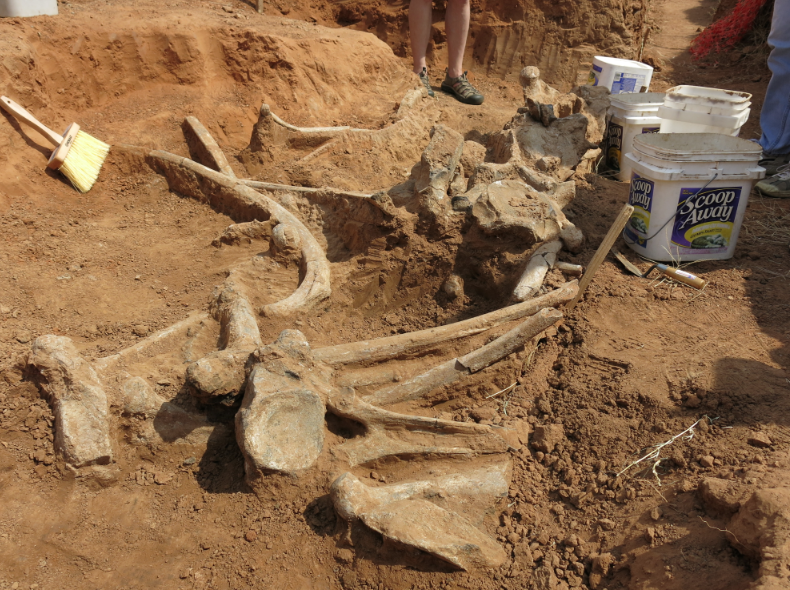OSU students and specialists unearth prehistoric mammoth
Wednesday, October 16, 2013

Oklahoma State University students are getting a rare chance to be involved in the excavation of a prehistoric mammoth at a location northwest of Enid. The mammoth’s remains were discovered by Access Midstream, a service provider who was installing a high-pressure natural gas line. The dig has been underway for a few weeks. The fossilized bones and fragments are being transported from the dig site to a lab on the OSU campus in Stillwater, where students and specialists will work together to reconstruct the mammoth.
“We are really fortunate to be involved in excavating such a find and the mammoth’s fossilized remains are in very good condition for this type of removal and reassembly,” said Dale Lightfoot, professor and head of the geography department at OSU, who witnessed the removal of the mammoth’s skull over the weekend.
Access Midstream officials say the mammoth find was a first for the company. “It’s not unusual to find fossils, but to find such a large animal and for it to be so complete is exciting,” said Environment Health and Safety Specialist Michael Rinehart. “Access is committed to following environmental best practices and we are pleased to work with OSU and the Oklahoma Archeological Survey for the preservation of these historic artifacts.”
While the researchers have not yet finished their analysis, they believe the recently discovered mammoth to be approximately 50,000 years old. They do know it is not a woolly mammoth, but most likely one of the other species, such as the Imperial Mammoth or the Columbia Mammoth, which were very abundant in the southern Great Plains.
Lightfoot credits geography graduate student Tom Cox for getting OSU involved at the dig site. Cox is working on his master’s degree under the advisement of Dr. Carlos Cordova, professor in the OSU geography department, and Dr. Lee Bement, a scientist with the Oklahoma Archaeological Survey and a member of Cox’ graduate committee. Cox, who has received training in geoarchaeology, was offered the opportunity to study the site by the Oklahoma Archaeological Survey, the institution called to the site when the mammoth remains were discovered.
“Dr. Lee Bement notified me since this is exactly the type of site I needed for my thesis research,” Cox said. “This is an excellent opportunity to get hands-on experience, and have the chance to gather my own data.”
Cox’s thesis falls within a broader study Cordova is carrying out in the Great Plains. The project seeks to reconstruct the prehistoric habitats of the mammoth and other large beasts. The project also includes the study of modern elephant habitats in southern Africa, which is used as a modern equivalent for understanding the relation mammoths had with their environment. Cox’s thesis research examines the landscape and the soils of these sites to assess a relative date of the sites.
“We also want to know why this animal is where it is, and possibly how it may have perished,” Cox said. “We believe that mammoths found higher in the landscape are older than those found in current flood basins. We also want to try and reconstruct the environment at the time of death, and the depositional forces that preserved it.”
In addition to Cox, more than 20 different volunteers, including undergraduate students from the geography, geology and zoology departments, have assisted with the excavation. Students will soon begin assisting specialists in the reconstruction of the bones with support from the Dean’s Excellence Fund. Depending on the condition of the remains, the group may seek funding for reassembly with the goal of a display on campus.
The OSU Utilities Department's Robert Bartmess and Ross Romero also helped at the dig site with equipment to provide a topographical map of the location of the remains.
